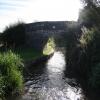
Plant's Bridge No 34
Address is taken from a point 383 yards away.

There is a bridge here which takes a track over the canal.
| Hazelhurst Lock No 11 | 2½ furlongs | |
| Hazelhurst Lock Bridge No 36 | 2 furlongs | |
| Hazelhurst Lock No 10 | 1¾ furlongs | |
| Hazelhurst Junction Footbridge No 35 | 1¾ furlongs | |
| Hazelhurst Junction | 1¾ furlongs | |
| Plant's Bridge No 34 | ||
| Hazelhurst Winding Hole | 1½ furlongs | |
| Brick Kiln Bridge No 33 | 2½ furlongs | |
| Smith's Bridge No 32 | 4¼ furlongs | |
| Park Lane Bridge No 31 | 5½ furlongs | |
| Park Lane Services | 6 furlongs | |
- Trent & Mersey Canal Society – founded in 1974 — associated with Trent and Mersey Canal
- Caldon & Uttoxeter Canals Trust — associated with Trent and Mersey Canal (Caldon Branch)
Mouseover for more information or show routes to facility
Nearest water point
In the direction of Froghall Tunnel (southwestern entrance)
In the direction of Etruria Junction
Nearest rubbish disposal
In the direction of Froghall Tunnel (southwestern entrance)
In the direction of Etruria Junction
Nearest chemical toilet disposal
In the direction of Froghall Tunnel (southwestern entrance)
In the direction of Etruria Junction
Nearest place to turn
In the direction of Froghall Tunnel (southwestern entrance)
In the direction of Etruria Junction
Nearest self-operated pump-out
In the direction of Etruria Junction
Nearest boatyard pump-out
In the direction of Etruria Junction
Wikipedia has a page about Plant's Bridge
Plants are mainly multicellular organisms, predominantly photosynthetic eukaryotes of the kingdom Plantae. Historically, plants were treated as one of two kingdoms including all living things that were not animals, and all algae and fungi were treated as plants. However, all current definitions of Plantae exclude the fungi and some algae, as well as the prokaryotes (the archaea and bacteria). By one definition, plants form the clade Viridiplantae (Latin name for "green plants"), a group that includes the flowering plants, conifers and other gymnosperms, ferns and their allies, hornworts, liverworts, mosses, and the green algae, but excludes the red and brown algae.
Green plants obtain most of their energy from sunlight via photosynthesis by primary chloroplasts that are derived from endosymbiosis with cyanobacteria. Their chloroplasts contain chlorophylls a and b, which gives them their green color. Some plants are parasitic or mycotrophic and have lost the ability to produce normal amounts of chlorophyll or to photosynthesize, but still have flowers, fruits, and seeds. Plants are characterized by sexual reproduction and alternation of generations, although asexual reproduction is also common.
There are about 320,000 species of plants, of which the great majority, some 260–290 thousand, produce seeds. Green plants provide a substantial proportion of the world's molecular oxygen, and are the basis of most of Earth's ecosystems. Plants that produce grain, fruit, and vegetables also form basic human foods and have been domesticated for millennia. Plants have many cultural and other uses, as ornaments, building materials, writing material and, in great variety, they have been the source of medicines and psychoactive drugs. The scientific study of plants is known as botany, a branch of biology.





















![Railway bridge near Denford, Staffordshire. The bridge is an accommodation bridge crossing the former railway line between Stoke and Leek or Cauldon Low. A public footpath across farmland also uses the bridge.The rail track is still in place. Plans are being made to re-open the line. http://www.mcrailways.co.uk/Another view of this bridge: [[[2496159]]]Accommodation bridges.When the canals (or railways) were built in the 18th and 19th centuries, they were often routed in such a way that farmers and other landowners had their land bisected, so bridges had to be provided to allow access to fields on both sides of the canal. These bridges are frequently referred to as accommodation bridges, and however solid and well constructed, often don't lead anywhere except from one field to another. by Roger D Kidd – 27 May 2011](https://s0.geograph.org.uk/geophotos/02/49/61/2496196_d930db5f_120x120.jpg)










![Meadowsweet stems and leaves by the old railway near Endon. By the track of the disused railway east of Endon, this foliage was growing up to a metre in height with a lot of small creamy-white flowers on top. It is also called Queen of the Meadows or meadow-wort (Filipendula ulmaria).See also: [[[6850369]]] by Roger D Kidd – 02 August 2015](https://s1.geograph.org.uk/geophotos/06/85/03/6850373_2fd2bb5b_120x120.jpg)